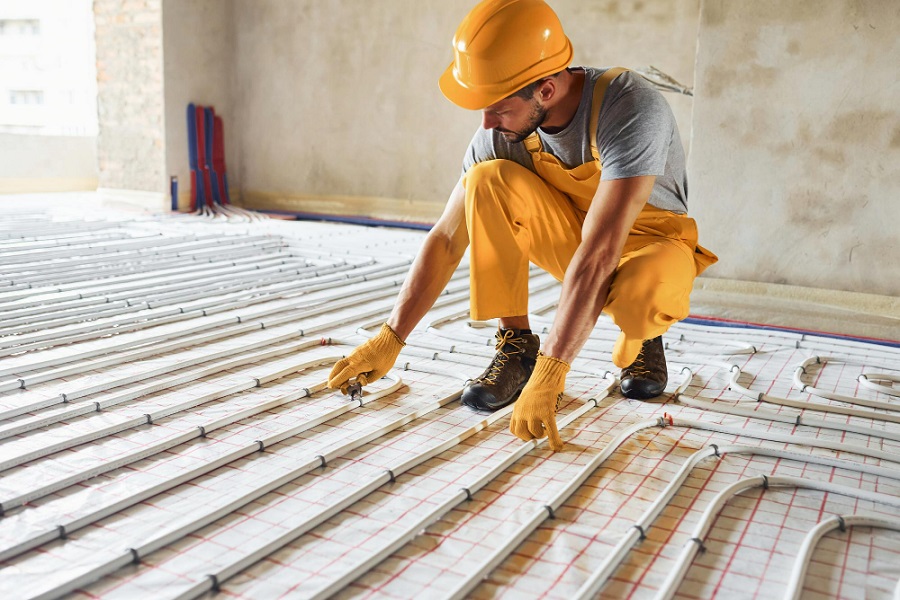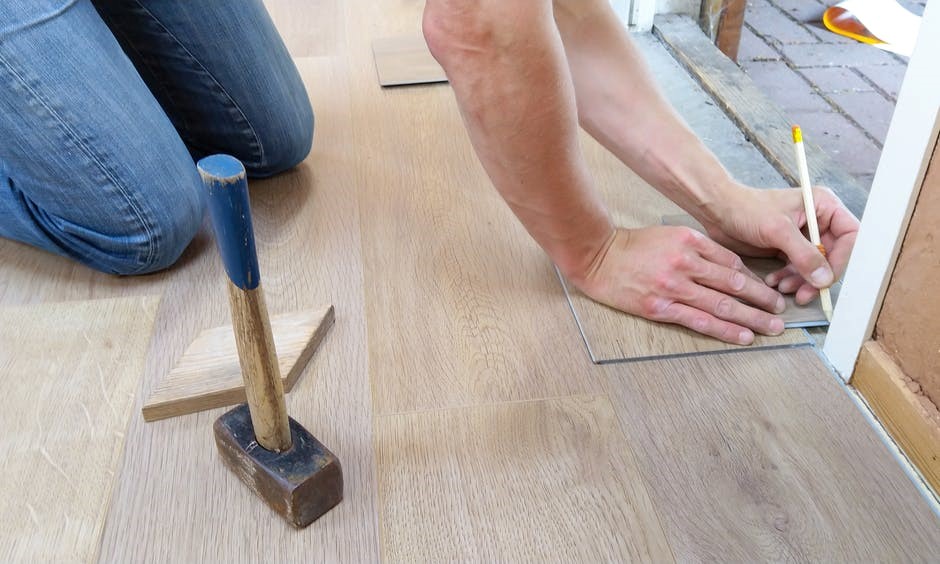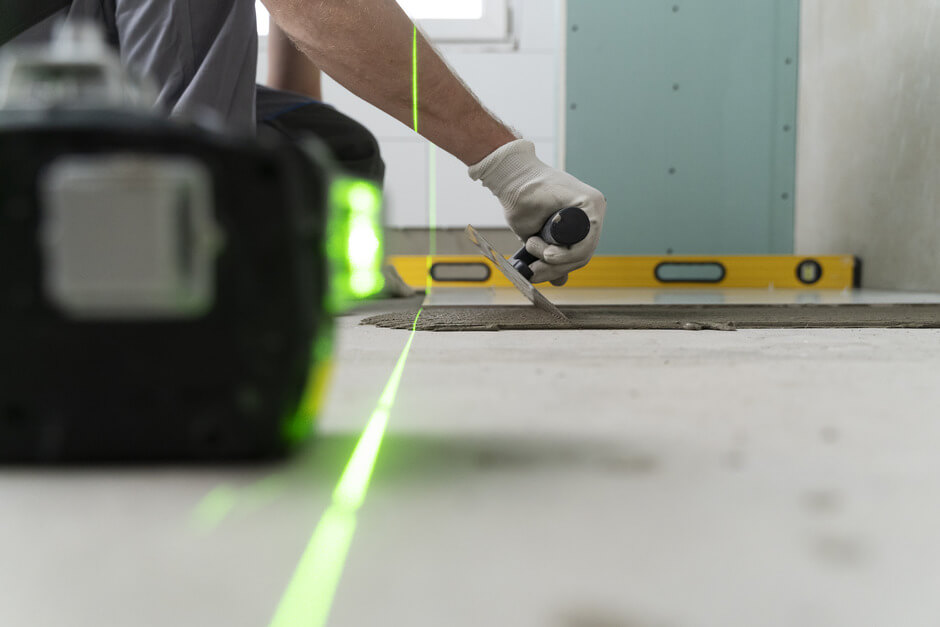
Vinyl flooring with underfloor heating has become an increasingly popular choice for homeowners seeking a comfortable and efficient heating solution. This innovative combination offers practicality and luxury, creating a warm and inviting ambience in any room. Whether considering electric underfloor heating for vinyl flooring or exploring different underfloor heating options, this article will guide you through the best choices explicitly tailored for vinyl floors. We will delve into the benefits and considerations of underfloor heating systems to ensure optimal performance with vinyl flooring. Join us as we uncover the perfect match between underfloor heating and vinyl, guaranteeing your home’s cosy and well-heated living space.
Table of Contents
Systems for Vinyl Flooring
When it comes to installing underfloor heating for vinyl flooring, several suitable systems can be considered. Each option offers unique benefits, and selecting the right one depends on factors like the subfloor type and desired heat output. Let’s explore the four different types of underfloor heating systems that work well with vinyl floors:
- Foil Heating Mat Systems:
Foil heating mat systems are an excellent choice for underfloor heating vinyl flooring. They consist of a heating cable attached to a foil mat, evenly distributing heat across the floor. These mats are easy to install and provide efficient warmth for your vinyl flooring.
- Heating Mats (100w, 150w):
Heating mats are another popular option, offering two variants: 100w and 150w. The choice between the two depends on the heat output required for your specific vinyl flooring. These mats are pre-spaced, making installation quick and hassle-free.
- In-screed Systems:
In-screed systems involve embedding the heating cables in a screed layer, which is then covered with vinyl flooring. This method ensures excellent heat retention and even distribution throughout the floor. However, it requires more effort during installation.
- Loose Cable Systems:
For greater flexibility in spacing, the loose cable system is ideal for vinyl flooring with underfloor heating. The heating cables are laid out manually, allowing you to adjust the spacing to suit your heating requirements. This system is compatible with both large and irregularly shaped rooms.
Before selecting a specific underfloor heating system, it is essential to assess the suitability of your subfloor. Solid screed and concrete floors or joisted wooden floors with 18mm WBP plywood covering are ideal for vinyl flooring with underfloor heating. In some cases, 18mm floorboards or waterproof chipboard can be used if they are in good condition and properly secured. To ensure proper insulation, you can cover these subfloors with either ProWarm™ tile backer boards or 12mm WBP plywood fixed every 300mm.
Once you’ve determined the appropriate subfloor and heating system type, you have two options to consider when installing the heating elements under vinyl floors. The first option involves using heating mats with a power rating of either 100w or 150w. The second option is the loose wire system, where the heating cables are spaced no closer than 65mm between loops, allowing for efficient and customizable heat distribution.
By carefully evaluating your subfloor, heat requirements, and installation preferences, you can select the best underfloor heating system for vinyl flooring, ensuring a warm and comfortable living space all year round.
Foil Heating Mats
When providing efficient and comfortable warmth for vinyl flooring, foil heating mats offer an excellent solution. These versatile mats are designed to be installed under various floor types, including laminate, solid wood, Vinyl, and carpet. However, checking with the floor manufacturer first is crucial to ensure compatibility. Remember that foil heating mats are unsuitable for use under glued-down or nailed-down floors.
One of the significant advantages of foil heating mats is their versatility, making them suitable for any room in your home, including bathrooms, kitchens, conservatories, extensions, and more. These mats, called under laminate heating, come in pre-assembled installation mats ranging from 1m2 to 12m2. Remarkably thin at only 2mm, they provide discreet and efficient underfloor heating for vinyl flooring.
The foil heating mats are 500mm wide and have full earth screening, utilizing an aluminium foil covering. This feature allows for installation in wet areas like bathrooms and kitchens, ensuring compliance with electrical and building regulations. With a power output of 140w per square meter, these mats provide ample warmth to keep your vinyl floors cosy and inviting.
To ensure proper functioning and safety, it is essential to install the foil heating mats per the instructions, particularly regarding maintaining earth continuity. Following the manufacturer’s guidelines during installation guarantees a reliable underfloor heating for vinyl flooring.
Wet Underfloor Heating and Electric Underfloor Heating Systems
Underfloor heating is a revolutionary way to achieve a cosy and evenly heated living space, making the floor a giant radiator. Regarding vinyl flooring, there are two central underfloor heating systems to consider: wet underfloor heating and electric underfloor heating.

Wet Underfloor Heating
Wet underfloor heating systems are commonly integrated into new build projects during the floor construction phase. In this setup, a network of pipework is embedded in a thick layer of screed, typically between 65mm and 75mm in depth. This water-based system requires careful consideration of additional load factors when designing and specifying the appropriate boiler. An underfloor heating manifold connects the pipework to the heat source, usually a boiler or heat pump, ensuring the water is at the right temperature to warm the floor above effectively. If you opt for wet underfloor heating, it’s crucial to consult with the manufacturer of your boiler or heat pump to ensure its compatibility with this system.
Electric Underfloor Heating
Electric underfloor heating is popular for renovation projects and new builds. This system has minimal impact on floor height and is relatively quick to install, depending on the room’s size. It involves installing an electric heating cable underneath the floor level, connected to the mains electricity supply, and controlled by a thermostat. Once activated, the heating cable warms up, generating radiant heat that gradually warms the surface of the vinyl floor. Your desired temperature is achieved within a mere 20-30 minutes, providing quick comfort and convenience.
Both wet and electric underfloor heating systems produce radiant heat, ensuring a more even and consistent spread of warmth compared to traditional central heating radiators. This even distribution eliminates disagreements over the room’s warmest spot, as the entire floor becomes a source of gentle, enveloping heat.
Does Underfloor Heating Work With Vinyl Floors?
If you’re considering underfloor heating for vinyl floors, rest assured that it is indeed a viable option. However, it’s essential to consider the varying properties of different types of vinyl flooring, such as Karndean, Amtico, Tarkett, and Click Vinyl. Checking the compatibility of your chosen vinyl type with the flooring manufacturer is crucial to ensure a successful and damage-free heating installation.
Vinyl flooring types can have specific temperature thresholds that, if exceeded, may cause undesirable damage to the flooring material. To avoid such issues, it is generally recommended to keep the underfloor heating system’s temperature with a vinyl floor finish at or below 27°C. To achieve this optimal temperature range and ensure efficient heating, it is prudent to conduct a heat loss calculation before making any purchase decisions. This calculation will help determine the appropriate underfloor heating system specifications, ensuring the room is heated effectively without overheating the floor.
Each vinyl flooring type may have unique heat conductivity properties, and it’s essential to understand these characteristics to ensure the underfloor heating system complements the Vinyl material. By checking the compatibility and adhering to recommended temperature guidelines, you can confidently enjoy the comfort and benefits of vinyl flooring with underfloor heating.

Tips When Installing Vinyl Flooring Over Underfloor Heating
When combining vinyl flooring with underfloor heating, proper installation is crucial to ensure the longevity and performance of your floor. Here are some essential tips to consider when laying vinyl flooring over underfloor heating:
Moisture
Before installing the vinyl floor finish, it’s essential to assess the moisture content of the substrate, especially with concrete substrates. Excessive moisture can damage water, causing bubbling, mould growth, and even rips at the seams of Luxury Vinyl Tiles (LVT). As most vinyl types are waterproof, the main concern is moisture beneath the flooring. Ensuring a dry and stable substrate is essential to prevent any potential issues.
Acclimatising the Vinyl
Unlike other floor finishes, Vinyl, particularly Luxury Vinyl Tiles (LVT), should be laid flat and allowed to acclimatize to the room for at least 24 hours before installation. The underfloor heating system should undergo two tests: one when you first receive it (for electric underfloor heating systems) and another after installation. A third test should be conducted after the vinyl flooring has been laid. Only turn on the underfloor heating system 48 hours after the vinyl installation to allow the floor finish to bond correctly, ensuring long-lasting performance.
Give Vinyl Solid Support
When installing vinyl flooring with underfloor heating system, adding a layer of support above the electric heating cables is crucial. This can be achieved by installing either High-Density Fiberboard (HDF) or cement overlay boards. The vinyl material is not strong enough to rest directly on the heating cable, and using adhesive to secure the Vinyl requires a smooth and stable surface for proper installation.
Following these tips ensures a successful and durable installation of vinyl flooring over underfloor heating. Proper moisture management, acclimatization, and providing solid support will help prevent potential issues and ensure a seamless and comfortable living space with warm vinyl flooring throughout your home.

What Type of Underfloor Heating System is Best to Use With Vinyl?
Both wet and electric systems can be viable options for underfloor heating for vinyl floors. However, as electric heating specialists, we’ll focus on electric systems, particularly the foil electric underfloor heating system, commonly favoured for vinyl floor finishes.
The foil electric underfloor heating system features a heating cable wrapped with two layers of foil, providing excellent thermal conductivity and rapid heat-up times. While similar in appearance, various electric underfloor heating systems have subtle differences that can impact their efficiency and practicality. These differences may include exposed cable loops for faster installation and whether the heating mat is fully earthed.
Best Electric Systems for Wet and Dry Rooms
Choosing the best electric underfloor heating system for your vinyl flooring will depend on whether your project is a new build or a retrofit, as well as the room type, categorized as either “Wet” or “Dry.”
Dry Rooms
Rooms without a significant water element, such as bedrooms, living rooms, hallways, and even kitchens with sinks and appliances, fall under the “Dry” category. In these areas, the foil heater electric underfloor heating system, used with an overlay subfloor to separate the system from the floor finish, is suitable for most vinyl floor finishes.
Wet Rooms
Underfloor heating can still be installed successfully for wet rooms with vinyl floors. Depending on your project’s specifications, we recommend using the DCM-PRO, StickyMat, or Loose Wire systems. Before laying the vinyl flooring, it is essential to cover the underfloor heating system with a 10mm deep layer of self-levelling compound to protect it from moisture.
There are many different types of wet room flooring that we cover in our guide.
Transfer of Heat Limits
For efficient system performance, following the transfer of heat limits is crucial. Everything above the heater, including underlay, overlay, and final floor finish, must comply with the specified limits. If the vinyl flooring manufacturer requires an underlay, it should be no more than 3mm to 6mm thick and breathable. Failure to meet these limits may hinder the system’s performance and result in undesired outcomes.
The figures below are for electric underfloor heating systems only. Water systems have a broader range of limits due to the specification variables.
| Tog | 1.5 (Unless otherwise stated) |
| RSI | 0.15m² K/W (Unless otherwise stated) |
Maximising Efficiency
While removing insulation boards may reduce the floor build-up height, it is strongly discouraged. Insulation boards play a significant role in preserving the heat generated by the underfloor heating system. Using uncoated boards for concrete subfloors and coated insulation boards for timber subfloors can boost the electric underfloor heating system’s efficiency by up to 50%.
To Finish
The foil system stands out as the best choice for underfloor heating systems paired with vinyl floor finishes. Its superior thermal conductivity and efficient heat distribution make it an ideal match for vinyl flooring, ensuring a comfortable and cosy living space.
It is crucial to maintain insulation to make the most of your electric underfloor heating system. Adequate insulation plays a significant role in maximizing the system’s efficiency, preventing heat loss, and ultimately saving on energy costs. With rising energy prices, ensuring proper insulation becomes even more critical for homeowners seeking to maintain a cost-effective, eco-friendly heating solution. If you have any questions or concerns about your electric heating setup, our dedicated team is here to help. We are readily available with valuable advice and expertise, aiming to save you both time and money while ensuring the optimal performance of your underfloor heating system
Choose Vinyl Flooring for Underfloor Heating
In conclusion, underfloor heating offers a fantastic heating solution for vinyl flooring, ensuring a cosy and evenly heated living space. When choosing the right system, consider the vinyl type’s compatibility and the room’s moisture content. Both wet and electric underfloor heating systems can work well with vinyl flooring. Still, the foil electric underfloor heating system stands out as a top choice for its excellent thermal conductivity and fast heat-up times.
For dry rooms, the foil heater electric underfloor heating system, used with an overlay subfloor, is suitable for most vinyl floor finishes. Underfloor heating can still be installed successfully in wet rooms with systems like DCM-PRO, StickyMat, or Loose Wire, protected by a 10mm deep layer of self-levelling compound.
To ensure optimal performance, adhere to the transfer of heat limits and never compromise on insulation, as it significantly impacts the system’s efficiency and energy costs. Properly installed underfloor heating will provide the ultimate comfort without overheating the floor or causing any damage to the vinyl material.
Whether you’re embarking on a new build or a renovation project, the foil system, combined with adequate insulation, ensures an efficient and cost-effective underfloor heating solution for your vinyl flooring. For any questions or guidance, our knowledgeable team is always available to offer valuable advice, ensuring a seamless and enjoyable heating experience in your home. Embrace the benefits of underfloor heating for vinyl flooring and enjoy a warm and inviting living space throughout the year.
FAQs
Is vinyl flooring suitable for use with underfloor heating?
Yes, vinyl flooring is generally suitable for use with underfloor heating systems. However, it is essential to check the manufacturer’s guidelines and recommendations for compatibility to ensure a successful installation.
What type of underfloor heating system is best for vinyl flooring?
Electric underfloor heating systems are often considered the best option for vinyl flooring. They provide a consistent and gentle heat that is well-suited for vinyl materials.
Can I install underfloor heating directly under vinyl flooring?
Yes, underfloor heating can be installed directly under vinyl flooring. However, it is crucial to follow the manufacturer’s instructions and guidelines for installation to prevent damage to the vinyl and ensure optimal performance.
Do I need to use any additional insulation with underfloor heating and vinyl flooring?
Insulation is generally recommended when installing underfloor heating with vinyl flooring. It helps improve the efficiency of the system by reducing heat loss and improving the overall performance.
How does underfloor heating affect the installation of vinyl flooring?
Underfloor heating can affect the installation of vinyl flooring by providing a warm surface for the flooring material. It is essential to ensure that the vinyl is properly acclimated to the room temperature and that any adhesive used is suitable for use with underfloor heating.
Can I install underfloor heating with luxury vinyl tiles (LVT)?
Yes, underfloor heating can be installed with luxury vinyl tiles (LVT). LVT is a type of vinyl flooring that closely resembles natural materials like wood or stone. It is generally compatible with underfloor heating, but it’s important to verify compatibility and installation guidelines with the specific LVT manufacturer.
Sources
Carpetright. (n.d.). Suitable for Underfloor Heating. Retrieved from https://www.carpetright.co.uk/vinyl/features/suitable-for-underfloor-heating/ (Accessed 19.07.2023)
